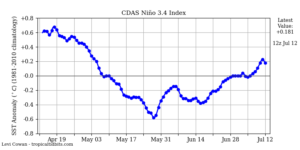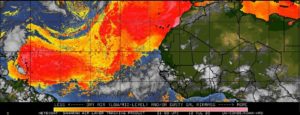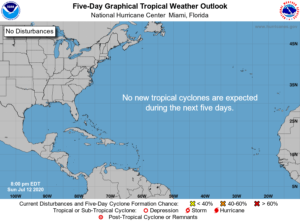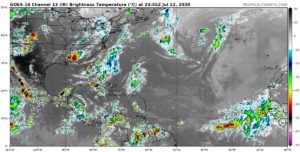Summary
We are slowly entering the 7th week of the 2020 hurricane season. The major development zone remains extremely calm which allows the West Indies to be too.
Dry air and sand are still very present on the MDR maintain rather unfavorable conditions for the development of cyclonic systems in the Atlantic. Unfortunately the shear is now quite low off the West Indies. 2 tropical waves circulate on the eastern half of the Atlantic.
If you are not subscribed to the Facebook group, do not hesitate to do it like the 40.000 other members to have immediate publication notifications: https://www.facebook.com/groups/meteo.tropicale/
A little bit of history
2 cyclones have affected the arc between July 13 and July 20 since 1950: Hurricane Emily, which passed over southern Grenada in category 1 in 2005 before becoming one of the earliest category 5 hurricanes, and storm Claudette moved to the Northern Islands in 1979.
ENSO situation
Water temperature in the Atlantic
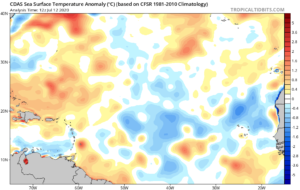 The water temperature anomalies in the Atlantic are generally negative in the major development zone. This is the effect of the thick haze of sand that has raged over the ocean for several weeks and which has blocked part of the solar radiation. Anything that can be caught in this area is good news for the next few weeks, especially if the haze lasts for a while.
The water temperature anomalies in the Atlantic are generally negative in the major development zone. This is the effect of the thick haze of sand that has raged over the ocean for several weeks and which has blocked part of the solar radiation. Anything that can be caught in this area is good news for the next few weeks, especially if the haze lasts for a while.
Atmospheric pressure situation in the Atlantic
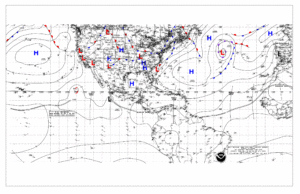 A depression over the Atlantic center has split the high into 2. The eastern part has moved up off France (and also brings very beautiful and warm weather) and the western half has slipped off the Bahamas.
A depression over the Atlantic center has split the high into 2. The eastern part has moved up off France (and also brings very beautiful and warm weather) and the western half has slipped off the Bahamas.
Isobar 1016 hPa is therefore inclined on an NE-SW axis. The situation should not continue because it is a rather unfavorable configuration for the West Indies in terms of the trajectory of the weather systems.
La ITCZ follows the same trend with a very active zone near Africa and another very calm zone on the western half due to the haze of sand.
Sand and dry air
Windshear / Shear
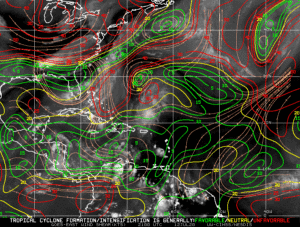 The tendency to weaken shear observed for 2 weeks has been confirmed in recent days. Windshears are now quite weak in the major development zone… which for the moment only leaves dust and dry air to maintain unfavorable conditions in the zone.
The tendency to weaken shear observed for 2 weeks has been confirmed in recent days. Windshears are now quite weak in the major development zone… which for the moment only leaves dust and dry air to maintain unfavorable conditions in the zone.
Despite this 3-week trend, the situation may improve again later in the season even if for the next few days the forecasts are not increasing.
NHC forecast
Prediction of GFS models
Access the animation (note heavy image, more than 3 MB)
Le GFS does not predict cyclonic systems over the Atlantic for the next 7 days. The ECMF is in the same position.
Satellite imagery
To read on the same subject:
So much for this 7th weekly point of the season in the new format.
Image credits; Tropical tidbits, NHC / Noaa, UW-CIMSS

